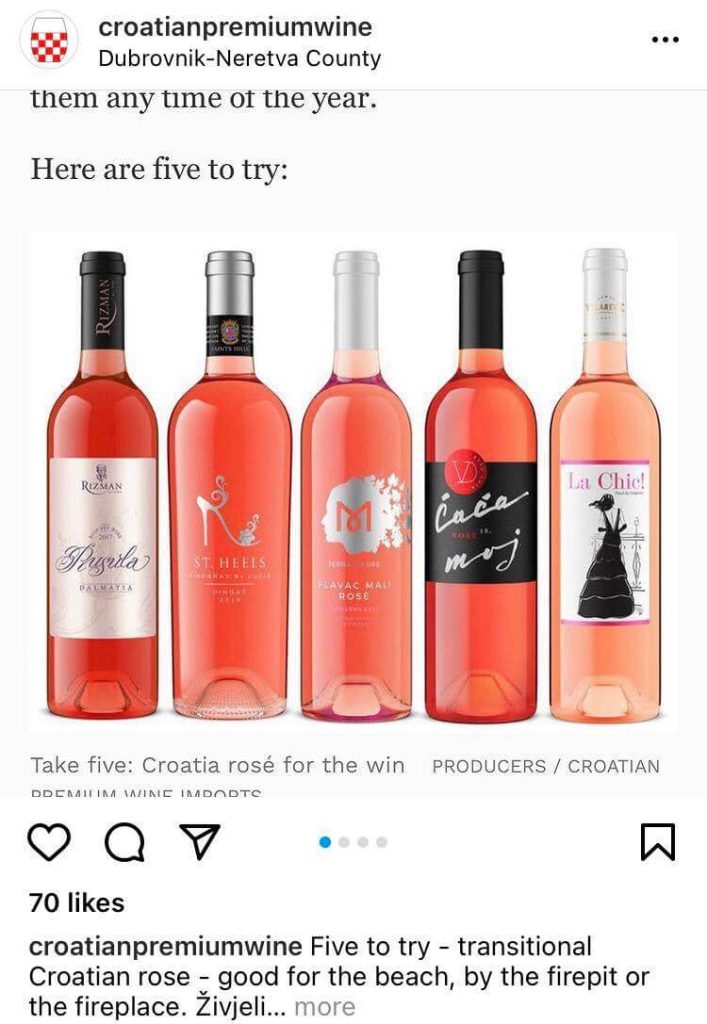Lana Bortolot, a certified wine and spirit expert who has been following trends in the wine industry for many years has given the beautiful Dalmatian rosés a big nod. The wine enthusiast, who also writes for top magazines and newspapers including New York Times, Wall Street Journal, and International Herald Tribune has recently published an article in Forbes praising the pink wines of Croatia and called it the “new transitional summer into fall wines”.
While there are still many who are unfamiliar with Croatian rosés, Mirena Bagur, the co-founder of the USA-based Croatian Premium Wine Imports Inc., claims that rosés have already been well-established in Croatia for more than a decade or so. Locally known as opolo, the rosé varieties are widely produced in the Dalmatian wine-growing areas. Croatian rosés are known for their transparent ruby hues with deep hints of mature red and black fruits and savoury herbal undertones. They are usually made from Plavac Mali – a special grape variety indigenous to Croatia. Due to the popularity of Plavac Mali, enthusiasts from all over the world marked September 21, 2021, as the first International Plavac Mali Day.
Clifford Rames, a sommelier in New York and a brand ambassador for Croatian wines pointed out the similarity of Croatian rosés with those produced from the south of France. “They are built with a sturdier structure and a moderate tannic grip making them ideal candidates for the grill and beyond.” According to him, even though Dalmatians usually enjoy their rosés with locally grilled cuisines such as fish, squid, and lamb over open olive-wood fires, Americans would enjoy pairing them with barbecued meats, burgers, tuna, and portabello mushrooms – dishes which tend to overpower the more delicate French counterpart. Clifford also introduced Darnekuša, Lasina, and Plavina, other varieties that are also indigenous to Croatia, which produce a lighter, coral pink rosés that can compete against Provencial rosés – both price-wise and quality-wise.
Mirena Bagur also additionally commented that each Croatian winemaker has their own version of rosé from Plavac Mali. According to her, Plavac Mali vines that were grown next to each other but processed by different winemakers could result in two very distinctive tastes and may easily be mistaken to be grown from different areas or even different varieties. “They have one thing in common, however, is that because of the tannic structure of Croatian rosés, they are best consumed at least after a year”, she added.
Here is Lana’s 5 recommended Croatian rosés to rid your summer blues:
Rizman “Rusula” 2019, Komarna
Grown in Southern Croatia, Rusula is made with 85% Plavac Mali and 15% Syrah. The pinkish tangerine color comes with hints of strawberries and herbs.
Saints Hills “St. Heels” 2019, Dingac
Lana advises not to get fooled by the playful stiletto heel on the bottle label because this wine is made from pure Plavac Mali with strong cherry and strawberry flavors that will knock your socks off.
Terra Madre “M” Plavac Mali Rose 2019, Komarna
Like Rizman’s Rusula, M is produced from 85% Plavac Mali and 15% Syrah, but it boasts a completely different flavour profile than the former. Thanks to the sour cherries and rhubarb which make the wine tart and crisp, this wine is pleasing to the palate.
Vina Deak Ćaća Moj 2018, Komarna
This savoury wine is made of 100% Plavac Mali with overtones of dried red fruits, herbs, and vegetables so it pairs well with charcuterie and grilled meats or vegetables.
Volarevic “La Chic!” 2019, Komarna
Another wine containing 100% Plavac Mali, its distinctive savoury taste comes from traces of garden fruits like rhubarb and tomato leaves. It’s great paired with food but also good on its own.
For more made in Croatia, follow TCN’s dedicated page.
For more about Croatia. CLICK HERE.











